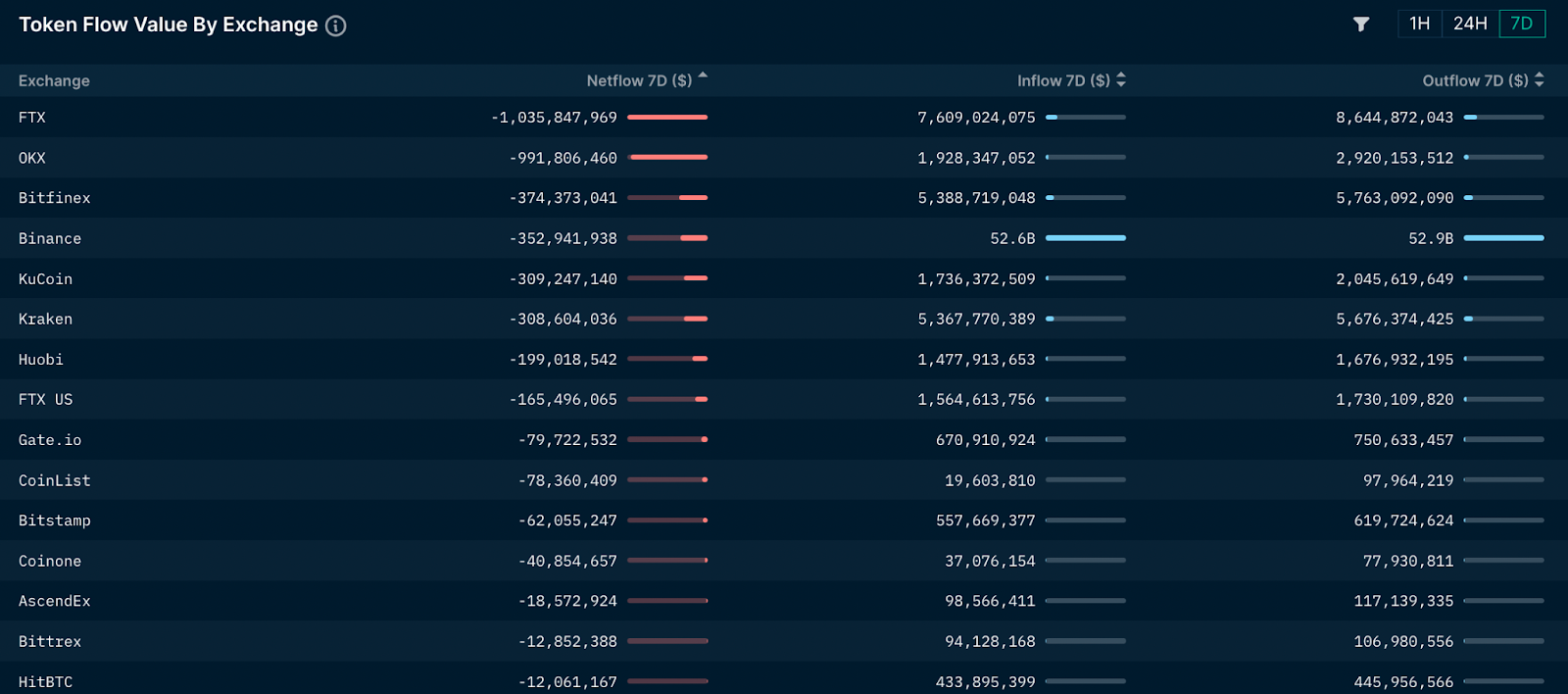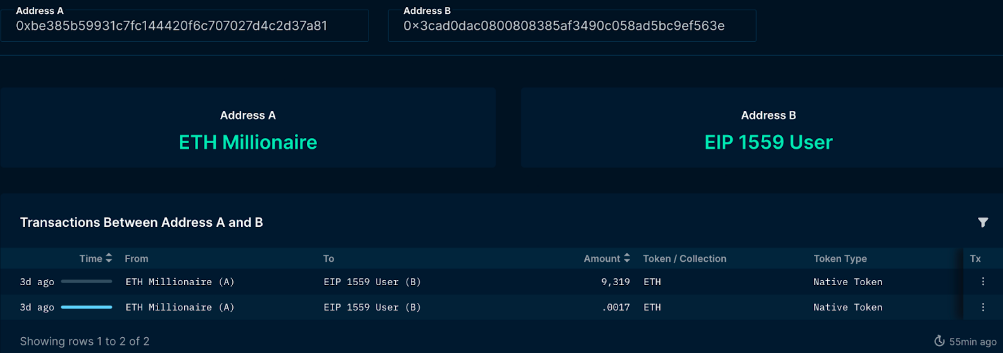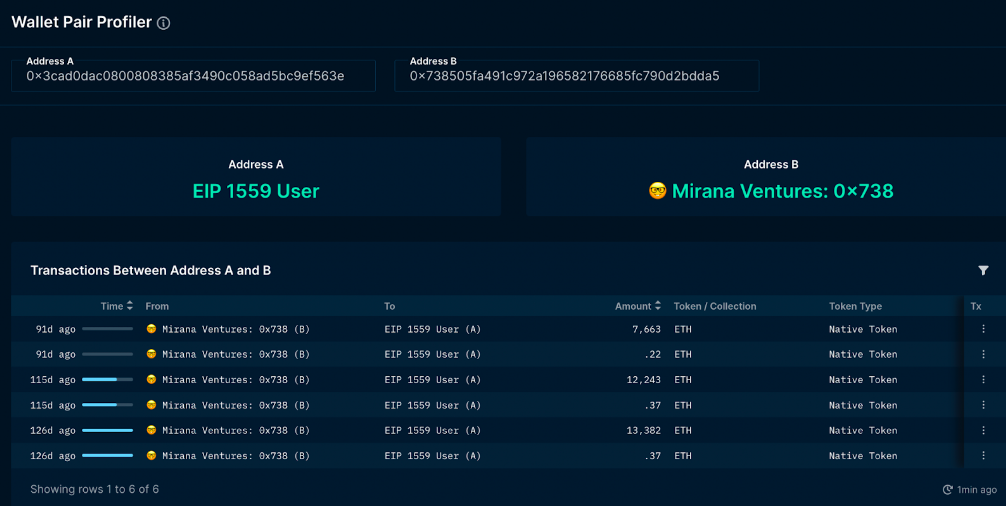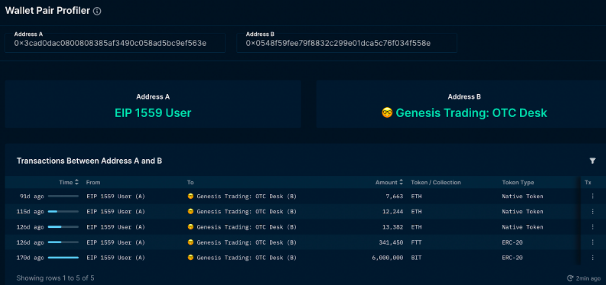
- Samuel Bankman-Fried’s FTX exchange and Alameda imploded due to Terra-UST ties, according to sources close to the matter.
- FTX exchange started processing customer withdrawals after nearly 48 hours of shutdown, on the lookout for a potential bailout.
- Whales and institutional investors made it out the door before the implosion, withdrawing most funds between November 6 and 8, 2022.
Cryptocurrency exchange FTX lent billions of dollars worth of customer assets to fund risky bets at Samuel Bankman-Fried’s trading firm Alameda Research. Sources close to the matter told the Wall Street Journal that this move resulted in the exchange’s implosion and liquidity crisis.
SBF’s teams at FTX and Alameda have ceased to provide a satisfactory explanation as to what really happened. On-chain forensics, sources confirmed and unconfirmed and tweets by SBF, FTX, Alameda and related entities make it clear that the crisis is rooted in Terra’s $41 billion collapse.
Also read: Is Justin Sun’s TRON empire a collateral in the FTX vs. Binance crypto war?
Timeline of FTX-Alameda crisis
Alameda Research, Samuel Bankman-Fried’s trading firm took big losses when Terraform Labs sister tokens LUNC (formerly LUNA) and UST imploded. Terra’s algorithmic stablecoin UST had an uncollateralized design, that made it more susceptible to failure and de-pegging, than other stablecoins.
May 2022- Terra’s LUNC(formerly LUNA) and UST imploded, wiping out $41 billion
Unconfirmed sources allege Alameda Research took huge losses through the $41 billion Terra implosion. Whistleblower and Terra community member FatManTerra alleged the involvement of Kanav Kariya, President of Jump Crypto, Do Kwon, CEO of Terraform Labs and Samuel Bankman-Fried, CEO of FTX exchange.
FatManTerra said that SBF had a 30% Serum handshake deal with Jump Crypto, therefore the FTX CEO had exposure to the Terra collapse.
@SBF_FTX I know about the 30% Serum handshake deal with Jump and what you did to retail investors after
— FatMan (@FatManTerra) May 23, 2022
June 2022- Samuel-Bankman Fried becomes crypto’s white knight
In June 2022 SBF went on a buying/ bailout spree and offered emergency relief funds worth nearly $750 million to crypto trade and storage service BlockFi and crypto asset broker Voyager Digital. The FTX CEO acquired BlockFi in the same month.
Why the acquisition and revolving lines of credit?
Sources close to the matter allege that Alameda was incentivized to bailout its insolvent lending counterparties to prevent collateral liquidation. The collateral for most loans was FTT, FTX exchange’s native token. This was done to avoid the mass liquidation of FTT which could possibly result in crumbling selling pressure on the exchange’s native token’s price.
For the whole story, check the nature of the relationship between involved parties in the image below:
Speculative theory shared by collective sources close to the matter
October 2022- Gabriel Shapiro, General Counsel at Delphi Labs leaks copy of draft of DCCPA bill
SBF stoked the ire of cryptocurrency influencers and big wigs through his blueprint for regulation that put the nail in the coffin for the DeFi industry. The biggest revelation was the Digital Commodities Consumer Protection Act (DCCPA bill) and how it came to be public knowledge.
A copy of the still in-progress Digital Commodities Consumer Protection Act (DCCPA), which outlines how the Commodities Futures Trading Commission would regulate the crypto industry, was uploaded to GitHub by Gabriel Shapiro. Shapiro acts as General Counsel to Delphi Labs, the research wing of investment firm Delphi Digital.
The DCCPA was introduced by Sens. Debbie Stabenow (D-MI) and John Boozman (R-AR) in August. Coinbase and FTX CEO Sam Bankman-Fried have openly supported the bill and it gained some traction because it offers an alternative to what has been described as regulation-by-enforcement strategy from the SEC.
Jake Chervinsky, head of policy at crypto lobbying group The Blockchain Alliance was quoted as saying,
This bill could be interpreted as a ban on DeFi.
November 6, 2022- FTX v. Binance war begins
SBF was critiqued by Changpeng Zhao, CEO of Binance and several prominent figures in the industry for his views on DeFi regulation. CZ announced his decision to sell $584 million in FTT tokens and triggered FUD (fear, uncertainty and doubt) in the community. FTT price collapsed from $22 to $3 soon after.
As part of Binance’s exit from FTX equity last year, Binance received roughly $2.1 billion USD equivalent in cash (BUSD and FTT). Due to recent revelations that have came to light, we have decided to liquidate any remaining FTT on our books. 1/4
— CZ Binance (@cz_binance) November 6, 2022
SBF’s FTX exchange and Alameda Research pulled all stops to defend FTT collapse, and failed. FTX’s native token is exchanging hands at $3.42 at press time.
Unconfirmed sources and crypto analyst Hsaka Trades alleged that SBF attempted to de-peg USDT since rival exchange Binance holds 17.6 million worth of Tether on its books.
Tether defended its peg and recovered to $0.99 after temporary de-peg from $1 to $0.97.
November 8, 2022- FTX reaches out to rival Binance for bailout
CZ told his 7.5 million followers on Twitter that FTX has reached out to Binance asking for a bailout. To support traders and protect the crypto community’s interest, Binance signed a Letter of Intent (LOI) to acquire FTX and began its due diligence in the exchange.
This afternoon, FTX asked for our help. There is a significant liquidity crunch. To protect users, we signed a non-binding LOI, intending to fully acquire https://t.co/BGtFlCmLXB and help cover the liquidity crunch. We will be conducting a full DD in the coming days.
— CZ Binance (@cz_binance) November 8, 2022
November 10, 2022- Binance scraps LOI to acquire FTX, USDD de-pegs, Justin Sun announces bailout plan
Just a day after saying they were going to acquire FTX, Binance cited concerns about the troubled exchange’s situation and that the business was beyond their “ability to help”, retracting the bailout offer. Hours after Binance’s announcement, Tron ecosystem’s stablecoin USDD suffered a de-peg and slipped from its $1 parity to $0.98. The cause was thought to be linked to Alameda dumping its holdings of USDD to defend itself from insolvency.
Justin Sun, founder of Tron, tweeted that he stands with Tron (TRX), BitTorrent (BTT), Just (JST), Sun Token (SUN) and Huobi Token (HT) holders. For the protection of token holders in the Tron ecosystem, Justin Sun and his team are in talks with FTX for a plan to bailout the exchange.
November 10, 2022- FTX reaches agreement with Sun, receives Tron credit facility
FTX exchange announced that they have reached an agreement with Tron to establish a special facility to allow holders of TRX, BTT, JST, SUN, and HT to swap assets from FTX 1:1 to external wallets. This functionality will be enabled at 18:30 GMT, November 10, 2022.
The exact capacity of the Tron Token facility will be determined weekly and future injections will occur at 14:00 GMT. The amount to be deposited will depend on a number of factors such as withdrawal demand and funding capacity to be provided by Tron.
As part of the agreement between FTX and Tron, the exchange disabled all Tron deposits for users and the only deposits will be the pre-announced deposits conducted weekly by the Tron Team.
Initially, $13,000,000 of assets will be deployed to facilitate swaps and information on future capital injections will be shared on a weekly basis. The announcement suggests TRX, BTT, JST, SUN and HT are likely to experience high levels of volatility.
November 10, 2022 – FTX exchange resumes withdrawals for Bahamian users
Experts on crypto Twitter identified withdrawals from FTX have begun. The exchange informed traders that in compliance with Bahamian regulations, withdrawals are being processed for users.
The amount withdrawn comprises a small fraction of assets that FTX currently holds and they are working on additional routes to enable withdrawals for the rest of the users.
1) Per our Bahamian HQ’s regulation and regulators, we have begun to facilitate withdrawals of Bahamian funds. As such, you may have seen some withdrawals processed by FTX recently as we complied with the regulators.
— FTX (@FTX_Official) November 10, 2022
Sam Bankman-Fried apologized to FTX international users on Twitter.
22) And, finally:
I sincerely apologize.
We’ll keep sharing updates as we have them.
— SBF (@SBF_FTX) November 10, 2022
FTX experienced a massive bank run, whales got out safe
Over the past week, FTX exchange processed over $8.7 billion in withdrawals, against $7.7 billion in deposits. This implies net outflows of nearly $1 billion. Unsurprisingly, this was the largest outflow compared to any other cryptocurrency exchange, in the same period.
Token flow by exchange
On-chain forensics reveal that the USD Coin (USDC) balance in FTX’s primary Ethereum hot wallet hit a peak at $408.3 million on October 26. Most withdrawals initiated during this period were from the trading firm Alameda Research. This leads to the question whether the firm pulled funds to meet liquidity requirements elsewhere.
FTX’s stablecoin liquidity was in free fall and the exchange wallet lost $137 million in USDC within 48 hours. After CZ’s tweet informing users of the $584 million FTT token sale and risk-management concerns at FTX, the bank run began to take hold.
FTX hot wallet USDC balance
Ethereum worth nearly half a billion dollars was pulled from FTX between November 5 and 7, 2022. 358,000 ETH was withdrawn from SBF’s exchange in the FUD and alleged rumors of a bank run.
ETH balance on FTX exchange
Nearly $1 billion worth of non-Ethereum ERC-20 tokens were withdrawn from FTX exchange between November 5 and 10. The on-chain analysis reveals that users safeguarded tokens with a higher market capitalization and liquidity first, before withdrawing smaller, less liquid tokes.
All ERC20 tokens withdrawn from FTX exchange
Hsaka Trades, a pseudonymous crypto analyst on Twitter believes large wallet investors were able to exit in a timely manner. Whales withdrew either all or part of their funds from FTX before the liquidity crisis unraveled, by November 8.
A wallet address 0xbe385b59931c7fc144420f6c707027d4c2d37a81 was able to withdraw $269 million of USDC and USDT from FTX and moved nearly $33 million to Binance.
Whale wallet withdrew $269 million from FTX before collapse
The above chart shows a series of transactions through which wallet A withdrew $269 million from FTX and moved nearly 12.2% of it to Binance.
The large wallet investor remains anonymous, however the transaction history points fingers at industry insiders. Consider node A, (0xbe385b59931c7fc144420f6c707027d4c2d37a81), which has interacted with B (0x0d71587c83a28e1adb9cf61450a2261abbe33632) which itself has a history of transactions with Genesis OTC and Three Arrows Capitals. These are prominent names that emerged in connection with Terra’s $41 billion implosion.
Wallet A and B’s transactions
A also interacted with C (0x3cad0dac0800808385af3490c058ad5bc9ef563e) that received funds from Mirana Ventures, the early stage investment arm of centralized exchange Bybit.
Wallet A and C’s transactions
C has a history of transfers to the same Genesis OTC wallet that B interacted with in the past.
Wallet C’s transactions
Wallet C’s transaction with Genesis OTC desk
On-chain data reveals FTX exchange and Alameda funds were co-mingled
A quick review of transactions between FTX and Alameda online revealed that the trading firm attempted to plug the liquidity issue that the exchange faced between November 5 and 7.
After receiving tens of millions from FTX in the last week of October 2022 and the first week of November 2022, Alameda moved nearly $360.9 million back to SBF’s exchange to fight the brewing liquidity crisis.
Evidence of $360.9 million inflow from Alameda to FTX
This information supports the idea that FTX’s funds were co-mingled with Alameda. No rational trading firm would deposit funds into an exchange that is experiencing a bank run. The inflow of $360.9 million from Alameda to FTX was an attempt to plug a hole, and it failed.
Firms come clean, deny relationship with Alameda and FTX
News of FTX exchange’s alleged bank run and co-mingling of finances with Alameda has become common knowledge over the past few days. Several crypto platforms, exchanges and entities have come forward denying any relationship or involvement with SBF’s FTX exchange and Alameda Research.
These third party denials, however, are redolent of the $41 billion Terra implosion, where crypto hedge funds shutdown withdrawals and filed for bankruptcies within a month of the event, despite initially denying involvement in the blowout.
Rumor has it that Alameda is going under after FTX’s collapse but on-chain data suggests otherwise. Larry Cermak of The Block has highlighted a set of suspected Alameda wallets that currently hold $50.9 million in non USD, ETH and BTC assets.
Of all the cryptocurrencies held by these wallets, the largest position is in BIT, the token of the centralized exchange Bybit. Alameda acquired BIT via a token swap for FTT. Alameda is still holding the 100M tokens, worth ~$32M at current prices.
List of non USD, ETH, BTC tokens held by Alameda
Alameda’s largest positions unrelated to SBF are xSUSHI and LDO, worth $5.8 million combined. If the trading firm liquidates its position in these tokens, it could result in a small supply overhang in the increasingly illiquid market.
Have FTX and Alameda dented the crypto industry?
Shuttling of funds between SBF’s two entities, FTX exchange and Alameda Research before and during the run on the exchange, supports the idea that the two were more closely tied financially. A very large entity, wallet A was able to withdraw hundreds of millions in stablecoins during the run, and the whale likely protected their holdings from the bank run.
Suspected Alameda wallets are still thought to have more than $50 million in tokens that are at risk of being liquidated in the open market. Alameda has north of $12 million in outstanding loans, at a very high risk of default.
The collapse of FTX is not limited to centralized exchanges and projects, as it has caused chaos across DeFi, with liquidity drying up for both MIM and USDT. Since Alameda was a major user of Abracadabra, it used native token FTT as collateral to mint Magic Internet Money (MIM). As of November 3, more than 35% of the outstanding MIM supply was backed by FTT.
Stablecoins USD Tether (USDT), USD Coin (USDC) and USDD (Tron ecosystem’s stablecoin) have suffered a de-peg, or temporarily nosedived below $1 parity. Stablecoins are crumbling under selling pressure as traders pull fiat out of the crypto market.
FTX filed for bankruptcy and Samuel Bankman-Fried resigned
Sources close to the matter have asserted that FTX, including FTX US, Alameda Research and approximately 130 related entities has filed for bankruptcy and CEO SBF resigned from his position at the exchange.
This is a developing story, as more on-chain activity and news comes to light, the story will be updated.
Here is a timeline of events to keep you updated:



-638037760545792427.png)
-638037762245797359.png)
-638037763012410610.png)







-638037769408588182.png)


















